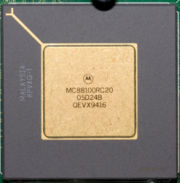- 88k
-
Der Motorola 88000 (kurz oft m88k genannt) ist eine RISC-Prozessor-Serie der Firma Motorola, die zu den 32-Bit-Prozessor-Architekturen gehört und als Nachfolger der 68000er-Familie konzipiert wurde.
Die Serie begann im April 1988 mit der Vorstellung des 88100 (CPU mit integrierter FPU) und des 88200 (MMU und Cache-Controller). Die Idee dieser Trennung war es, das Design eines Multiprozessor-Systems zu vereinfachen (Ein 88200 konnte bis zu vier 88100 verwalten.), hatte aber auch den Nachteil, dass schon für ein System mit nur einer CPU der zweite Chip und die Verbindungen der Bausteine miteinander notwendig war, was die Kosten für ein solches System nach oben trieb. Später wurde mit dem 88110 ein Chip entwickelt, der eine MMU enthielt, und dazu passend den Cache-Controller 88410. Der 88110MP war noch mehr auf Multiprozessor-Betrieb optimiert. In Entwicklung befand sich eine superskalare Version mit dem Namen 88120, die jedoch nicht mehr in Serie ging.
Ende der 1980er Jahre wurde die Entwicklung der m88k-Serie von vielen Firmen verfolgt, vor allem von Apple und NeXT, letztere hatten sogar schon Prototypen mit m88k-Prozessoren hergestellt. Data General setzte die Serie in deren AViiON-Baureihe und die japanische Firma OMRON im Modell LUNA88K ein, ansonsten gab es aber keine nennenswerten Abnehmer. Anfang der 1990er Jahre wurde die m88k-Serie zugunsten des PowerPC eingestellt.
Die MMU der Motorola 88000 wurde weitgehend in die erste Generation der PowerPC Prozessoren übernommen, allerdings zusammen mit dem Prozessor auf einem Chip realisiert.
Weblinks
- http://badabada.org - Informationen über die 88000er-Serie und Computer, in denen sie eingesetzt war
- http://www.geekdot.com/m8120/ Motorola M8120 System (englisch)
Wikimedia Foundation.

